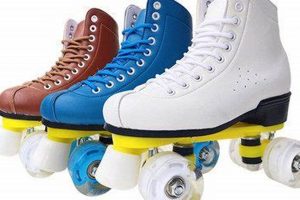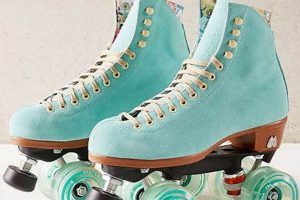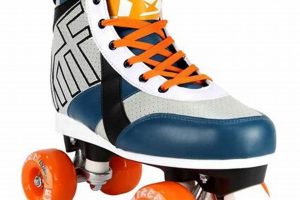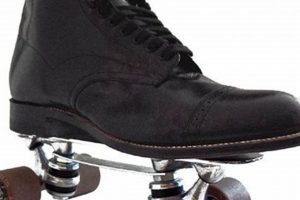A small, often T-shaped or multi-tool, designed specifically for adjusting and maintaining roller skates. It typically incorporates wrenches or sockets of various sizes to loosen or tighten axle nuts, toe stop screws, and kingpin nuts. A common example is a tool featuring 9/16″, 1/2″, and 5/16″ sockets, allowing for comprehensive skate maintenance.
The described implement is crucial for optimal skate performance and safety. Routine adjustments ensure proper wheel spin, prevent excessive wear on components, and allow skaters to customize their skate’s feel. Historically, skaters relied on general-purpose tools, but the dedicated design provides better leverage, precision, and reduces the risk of damaging delicate skate parts. Consistent use extends the lifespan of roller skates and prevents injuries resulting from loose or improperly adjusted components.
The following sections will delve into the specific applications of this tool, explore different types available, and provide a guide to performing essential roller skate maintenance procedures.
Roller Skate Adjustment Guidance
The following provides actionable advice for maintaining and adjusting roller skates using the designated implement. Proper application of these techniques ensures both optimal performance and skater safety.
Tip 1: Axle Nut Tightness: Regularly inspect axle nuts. Over-tightening restricts wheel spin, while under-tightening allows for wheel wobble, creating instability and potential equipment failure. Adjust the nut to permit free wheel movement with minimal side-to-side play.
Tip 2: Toe Stop Height Adjustment: Alter the toe stop height according to skating style and preference. Lower placement provides quicker stops and increased agility; higher placement offers enhanced stability. Ensure both toe stops are equidistant from the ground.
Tip 3: Kingpin Nut Adjustment: The kingpin nut controls skate turning responsiveness. Loosening this nut allows for easier turning, while tightening it increases stability. Adjust both skates equally to maintain balance and prevent uneven wear.
Tip 4: Tool Condition Maintenance: Keep the instrument clean and free from rust. Lubricate moving parts, such as socket swivels, to ensure smooth operation and prevent damage to skate hardware. A well-maintained tool ensures accurate adjustments and extends its lifespan.
Tip 5: Thread Inspection: Prior to tightening any nut or screw, examine the threads for damage or debris. Damaged threads can lead to improper tightening and potential equipment failure. Clean or replace damaged hardware as needed.
Tip 6: Controlled Force Application: Exercise caution when tightening nuts and screws. Excessive force can strip threads or damage skate components. Use a moderate amount of force and check for proper tightness after each adjustment.
Adhering to these recommendations ensures a safe and enjoyable skating experience. Regular maintenance and precise adjustments prolong equipment life and enhance performance.
The following concluding remarks summarize the key points discussed and offer additional resources for roller skate maintenance.
1. Socket size specificity
Socket size specificity is a critical design element of any tool intended for roller skate maintenance. The tool must incorporate sockets precisely matched to the standardized sizes of nuts and bolts used on roller skates. A mismatched socket will either be ineffective or, more seriously, damage the hardware, potentially stripping threads or rounding off nut edges. This can lead to component failure and compromise the skater’s safety. For instance, attempting to tighten a 9/16″ axle nut with a 1/2″ socket may initially seem functional, but the imprecise fit can deform the nut, making it increasingly difficult to properly tighten or remove in the future.
The need for socket size specificity extends to various adjustment points on a roller skate. Typically, a comprehensive maintenance tool includes sockets sized for axle nuts (often 9/16″), kingpin nuts, and toe stop adjustment screws (frequently 5/16″ or similar). Manufacturers design these tools to streamline the adjustment process, eliminating the need for a collection of individual wrenches. The presence of appropriately sized sockets within a single instrument ensures that a skater can quickly and efficiently address common maintenance issues, such as loose wheels or improperly adjusted toe stops, before or during a skating session.
In conclusion, socket size specificity represents a fundamental requirement for any effective tool intended for roller skate maintenance. Without precisely sized sockets, the tool’s ability to perform its intended function is compromised, potentially leading to damage to the skate hardware and compromising the safety of the skater. Therefore, selection should prioritize tools offering a range of appropriately sized, high-quality sockets tailored to standardized skate component dimensions.
2. T-Shape Leverage
The incorporation of a T-shaped handle in roller skate maintenance tools directly impacts the user’s ability to apply torque effectively. This design is not merely aesthetic; it represents a functional advantage, facilitating secure tightening and loosening of critical skate components.
- Mechanical Advantage Amplification
The T-shape design inherently increases mechanical advantage. By providing a longer lever arm, the required force to turn a nut or bolt is reduced. This is particularly important when dealing with corroded or tightly secured components on roller skates, preventing strain and potential injury to the user.
- Enhanced Grip and Control
The T-shape allows for a more secure and ergonomic grip compared to in-line or straight-handled tools. This improved grip enhances control during adjustments, minimizing the risk of slippage and potential damage to skate hardware. Furthermore, a firm grip facilitates accurate torque application.
- Optimized Force Distribution
The T-shape distributes force more evenly across the user’s hand, reducing localized pressure points. This is essential for prolonged maintenance tasks, preventing fatigue and ensuring consistent performance. Uneven force distribution can lead to inaccurate adjustments and potential over-tightening.
- Accessibility in Confined Spaces
While not always the primary advantage, the T-shape can offer improved access to nuts and bolts situated in confined spaces on certain skate models. The perpendicular orientation of the handle allows the user to maneuver the tool around obstructions, simplifying the adjustment process.
The T-shaped handle represents a significant design element enhancing the functionality and usability of implements utilized for roller skate maintenance. Its contribution to mechanical advantage, grip, force distribution, and accessibility collectively improves the efficacy and safety of skate adjustments.
3. Portability Essential
The characteristic of portability is not merely a convenience but a fundamental requirement for the effectiveness of the implement used for roller skate maintenance. The inherently mobile nature of roller skating necessitates that adjustment and repair capabilities be readily available to the skater, regardless of location. The tool’s efficacy is directly proportional to its accessibility.
- On-Site Adjustments:
Roller skating environments are rarely static. Conditions, surfaces, and skater preferences necessitate frequent adjustments. A easily transported allows for immediate adaptation, optimizing performance. For instance, loose axle nuts discovered during a rink session can be addressed instantly, preventing potential wheel detachment and injury.
- Competition Preparedness:
Competitive roller skating demands precise equipment calibration. The tool’s ability to be transported to competitions ensures that skaters can fine-tune their skates prior to events and address any unexpected issues that may arise. This is particularly crucial in disciplines where even minor adjustments can significantly impact performance.
- Remote Skate Sessions:
Roller skating often occurs in locations removed from traditional maintenance facilities, such as parks, trails, and urban environments. Portability ensures that skaters can address mechanical issues encountered during these remote sessions, preventing minor problems from escalating into more significant complications. The instrument becomes an essential component of the skater’s personal equipment.
- Space Constraint Considerations:
Skaters frequently travel to skating locations via public transportation, bicycle, or compact vehicles. A large maintenance kit would be impractical for transport. The key’s diminutive size, that makes it so easy to be transported, allows skaters to practice and maintain their skates at any given place without burdening them with a lot of weight, or an excess number of big tools.
The facets of on-site adjustment, competition preparedness, and remote session support collectively underscore the essential nature of portability in the context of a roller skate maintenance tool. These features ensure that skaters can maintain their equipment in diverse environments and that the tool fulfills its intended function effectively, enhancing both performance and safety.
4. Material Durability
Material durability is a critical determinant of a roller skate key tool’s longevity, reliability, and overall effectiveness. The repeated application of torque during skate maintenance places substantial stress on the tool’s structural integrity. Inferior materials yield to deformation or fracture, rendering the tool useless and potentially damaging skate components. A tool fabricated from hardened steel, for example, will withstand significantly more force and resist wear compared to a tool made from softer alloys. This directly impacts the tool’s ability to perform essential tasks, such as tightening axle nuts or adjusting toe stops, ensuring secure and consistent skate performance.
The selection of materials directly affects the tool’s resistance to environmental factors, a practical consideration for skaters who often maintain their equipment outdoors. Moisture exposure leads to corrosion, weakening the tool and potentially seizing moving parts. Tools constructed from stainless steel or treated with protective coatings exhibit enhanced resistance to corrosion, extending their operational lifespan. Similarly, the material’s resistance to abrasion is crucial, as repeated use can gradually wear down socket edges, compromising their grip on nuts and bolts. High-carbon steel, known for its hardness and wear resistance, mitigates this risk. For instance, a tool used daily by a competitive skater requires superior material durability to withstand the constant demands of adjusting and maintaining multiple sets of skates.
In summary, material durability is inextricably linked to the functionality and lifespan of a roller skate key tool. The tool’s ability to withstand mechanical stress, resist environmental degradation, and maintain precise socket dimensions directly influences its effectiveness in performing essential skate maintenance tasks. Prioritizing tools constructed from high-quality, durable materials ensures reliable performance, extends the tool’s lifespan, and ultimately protects the skater’s investment in their equipment.
5. Multi-functionality Imperative
The demand for multi-functionality in a roller skate key tool arises from the diverse array of adjustments and maintenance tasks required to maintain a roller skate. A single-purpose tool necessitates carrying multiple implements, increasing bulk and the potential for loss or misplacement. A tool integrating multiple functions streamlines the maintenance process, enabling a skater to address various needs with a single, compact device. The absence of multi-functionality leads to inefficiency and potentially compromises the skater’s ability to respond to unforeseen issues during a session. For instance, a loose axle nut may require a specific wrench size, while a misaligned toe stop demands a different tool altogether. An skater burdened with carrying multiple tools may delay or forgo necessary adjustments, potentially leading to unsafe skating conditions.
Multi-functionality typically manifests as a combination of different socket sizes, screwdriver bits, and potentially other specialized features within a single tool body. A common configuration includes sockets for axle nuts, kingpin nuts, and toe stop adjustments, covering the most frequent maintenance needs. Some advanced tools may incorporate a bearing press or extraction feature, streamlining wheel maintenance. The practical implication of this integration is a reduction in the number of tools required, simplifying the skater’s gear and accelerating the maintenance process. Consider a scenario where a skater needs to adjust both the axle nuts and the toe stops on their skates. A multi-functional tool allows them to accomplish both tasks without switching tools, saving time and minimizing disruption to their skating session.
In essence, the multi-functionality imperative dictates that a roller skate key tool should encompass a comprehensive set of capabilities within a single, portable design. This requirement stems from the diverse maintenance demands of roller skates and the need for efficient, on-the-go adjustments. While the specific functions may vary based on skater preferences and skating discipline, the underlying principle remains constant: a multi-functional tool enhances the skater’s ability to maintain their equipment effectively, promoting both performance and safety. The challenge lies in balancing functionality with size and weight, ensuring that the tool remains manageable and portable without compromising its structural integrity or usability.
Frequently Asked Questions About Roller Skate Key Tools
The following addresses common inquiries regarding the function, selection, and proper utilization of the implement designed for roller skate maintenance. These answers provide clarity and guidance for effective skate maintenance procedures.
Question 1: What specific functions should a comprehensive roller skate key tool perform?
A comprehensive tool should, at minimum, facilitate the adjustment of axle nuts, kingpin nuts, and toe stops. The inclusion of bearing press functionality is beneficial but not always essential.
Question 2: What are the primary risks associated with using an improperly sized roller skate key tool?
Using an improperly sized tool risks damaging the skate hardware, specifically stripping threads or rounding off nut edges. This compromises the integrity of the skate and may necessitate costly repairs.
Question 3: How frequently should a skater inspect and maintain the roller skate key tool itself?
The tool should be inspected regularly for signs of wear, corrosion, or damage. Moving parts, such as socket swivels, should be lubricated periodically to ensure smooth operation.
Question 4: Is there a universal sizing standard for roller skate key tools, or do sizes vary between skate brands?
While socket sizes tend to adhere to standardized dimensions, minor variations may exist between skate brands. It is advisable to confirm compatibility prior to use, particularly with vintage or specialized skate models.
Question 5: What materials offer optimal durability for a roller skate key tool intended for frequent use?
Hardened steel, stainless steel, or high-carbon steel offer superior durability for tools subjected to frequent use. These materials resist deformation, corrosion, and wear, ensuring prolonged tool lifespan.
Question 6: Can a general-purpose wrench set adequately substitute for a dedicated roller skate key tool?
While a general-purpose wrench set may suffice in certain situations, a dedicated roller skate key tool offers improved leverage, precision, and often integrates multiple functions within a compact design. A dedicated tool is preferable for routine skate maintenance.
These responses provide a foundational understanding of critical considerations related to the described implement. Adherence to these guidelines ensures proper skate maintenance and promotes safe skating practices.
The subsequent section offers a concluding summary of the key topics discussed throughout this document.
Conclusion
This exploration has detailed the multifaceted role of the roller skate key tool, emphasizing its importance in maintaining skate performance, safety, and longevity. Socket size specificity, T-shape leverage, portability, material durability, and multi-functionality have been identified as critical design elements. The consistent and correct utilization of such tool is paramount for every skater.
A proper understanding of the discussed information is not optional, but crucial. Skaters are strongly advised to prioritize regular maintenance of their equipment and adhere to recommended safety guidelines. The appropriate application of this instrument extends equipment lifespan and ensures a secure and enjoyable skating experience.







